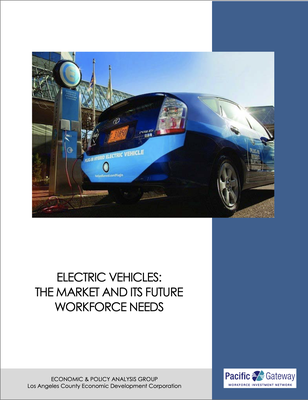Workforce Development
Summary for Decision Makers
Holistic workforce development strategies lay the groundwork for thriving EV markets
New technologies such as EVs struggle to become mainstream without a larger ecosystem of trained, skilled professionals who provide services that keep EVs operational and safe. Workforce development can entail standardized education, training, certifications, apprenticeships, and tracking the EV workforce needs over time because EV deployment may create new jobs across multiple sectors. Workforce development is a critical but often overlooked building block of EV market development.
What Is Workforce Development?
Workforce development aims to ensure that a workforce has the skills, training, and experience needed to support EV deployment and fully take advantage of its economic benefits. It encompasses myriad strategies, common across other relatively new renewable energy industries (e.g., solar, wind), including:
- Standardized education and training at all levels of education (e.g., primary school through higher education)
- Industry-based training, certification, and apprenticeships that build professional capacity on an ongoing basis
- Understanding labor market dynamics over time to ensure programs and policies match labor supply with job demand.
Understanding the EV Workforce
Tracking the EV labor market as it evolves can ensure that policies and programs meet current and evolving industry needs
EV workforce development policies and programs, like their counterparts in the solar and wind industries, must understand and be responsive to labor market (i.e., supply-demand) dynamics to prepare enough skilled workers for jobs that exist now and will exist in the future. Key labor market factors that decision makers should regularly consider to build and expand EVs include:
- Types of occupations needed: What types of occupations are needed to build and sustain EVs in a local, regional, national market? Are there existing occupations that could expand into this space (with additional training) or are entirely new jobs and skill sets needed?
- Anticipated growth rate for jobs: How many jobs will be needed to support EV deployment and when? How can one ensure that labor supply and demand match? How will job growth change as the industry expands?
- Current challenges facing firms: How difficult is it for firms to find qualified labor? What skillsets do firms need?
- Size of local job markets and regional distribution of jobs: How can one discourage the training workers into non-existent or declining job markets? What kind of firms hire for specific types of roles in the EV market? Where are they located?
- Typical wages: What are employers willing to pay for services? What kind of wages can workers expect in this industry? How do these wages compare with the cost of education required to perform in these jobs?
- Equity concerns: How can representation of women and other minorities in EV workforce development be best increased?
What Kinds of Jobs May EVs Create?
EV deployment may create new jobs across multiple sectors
Anticipated growth in EV deployment raises questions about if, how, and when jobs may be affected. In particular, established automotive industries in Europe and the United States have voiced concern about the potential effects of electromobility on manufacturing jobs, largely because production of battery electric cars is expected to be less complex and labor intensive than ICEs (Fraunhofer IAO 2018; Dawson, Naughton, and Coppola 2019; Harrison 2018; Perk et al. 2018). Perk et al. (2018) categorize electromobility jobs by:
- Production of batteries and chargers
- Sales of electrical equipment
- Installation, connection to grid, operation, and maintenance of chargers
- Associated grid reinforcements
- Civil and road work
- Production of additional electricity.
Importantly, research to date notes that electromobility will transform employment as we know it, as jobs are expected to shift “downstream” away from manufacturing to installation, operation, and maintenance of charging points (Figure below) (Perk et al. 2018; Harrison 2018; Deloitte 2021). Understanding how EV deployment may affect traditional auto manufacturing and job development more broadly can help decision makers determine if and how some types of workers will be displaced and prepare retraining programs in response.
 For developing countries, these study results shed light on where across the EV value chain job opportunities may lie and thus suggest key workforce areas for reinforcement, development, or expansion. Several countries in the developing world with notable traditional automotive industries such as Thailand, see great opportunity to become regional hubs for EV production and are aligning national policies to support this objective (Thanthong-Knight 2021). Similarly, Vietnam’s existing EV automaker, VinFast, has ambitions plans to expand its research, development, and manufacturing capacity, which are bolstered by supportive government policies to incentivize purchase of VinFast vehicles (Deloitte 2021). Even if countries do not have established automotive or battery manufacturing industries (or anticipate them developing), as is the case in much of the world, EV deployment still holds the promise of job creation across other important sectors.
For developing countries, these study results shed light on where across the EV value chain job opportunities may lie and thus suggest key workforce areas for reinforcement, development, or expansion. Several countries in the developing world with notable traditional automotive industries such as Thailand, see great opportunity to become regional hubs for EV production and are aligning national policies to support this objective (Thanthong-Knight 2021). Similarly, Vietnam’s existing EV automaker, VinFast, has ambitions plans to expand its research, development, and manufacturing capacity, which are bolstered by supportive government policies to incentivize purchase of VinFast vehicles (Deloitte 2021). Even if countries do not have established automotive or battery manufacturing industries (or anticipate them developing), as is the case in much of the world, EV deployment still holds the promise of job creation across other important sectors.


